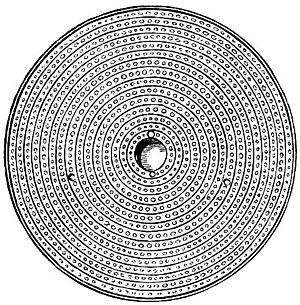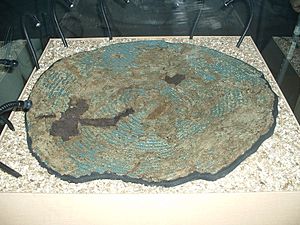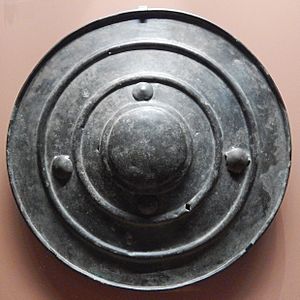Yetholm-type shield facts for kids
The Yetholm-type shield is a special kind of shield from the Bronze Age. This was a time long ago, between 1200 and 800 BC. Most of these shields have been found in Britain and Ireland. One shield was even found in Denmark.
These shields get their name from a place called Yetholm in southern Scotland. Three shields were discovered there in a peat bog. We know about 22 of these shields today. Some are broken, and a few more are only known from old writings. Even though they come in different sizes, they all look quite similar.
Ancient rock carvings from Scandinavia show shields with circles or dots. These carvings look a lot like the Yetholm-type shields. These amazing shields were likely owned by important people. They showed that someone had a high place in their society.
Contents
How Were Yetholm Shields Made?
These ancient shields were made from a thin sheet of metal. This metal was a type of bronze called high-tin bronze. It was a mix of copper and a lot of tin. The metal sheet was only about half a millimeter thick.
Crafting the Shield's Shape
The shields are round with a raised bump in the middle. This bump is called a shield boss. The boss was made by carefully hammering the metal from the back. The front of the shield has many raised circles. These circles are like ridges, each a few millimeters high. Between these ridges, there are rows of small, round bumps. These bumps are about 4 millimeters wide.
The patterns were made by hammering the metal from the back. This special method is called Repoussé. It makes the design stick out on the front.
Adding the Rim and Handle
The outer edge of the shield was folded back. Then it was hammered flat. This made the rim very strong. A handle was attached across the middle bump. It was made from a thicker piece of bronze. There were also metal loops for a carrying strap. Small metal pins, called Rivets, held these parts on. The rivet heads on the front look like the decorative bumps. This makes them hard to spot.
The Skill of the Makers
It is thought that a special tool was used to make the bumps. This tool would have made them all the same size. The metal was probably placed on a soft surface while being hammered. This could have been a bed of pitch or lead. The people who made these shields were very skilled. They had to be careful with the spacing of the bumps. If they got to the end of a circle, they would adjust the spacing slightly. This made the design look perfect. Because the shields are so similar, they were likely made by a few experts in the same workshop.
Different Kinds of Yetholm Shields
Yetholm shields come in different sizes. They also have different numbers of raised circles. But the size of the bumps on them is always the same. The biggest shield found has 29 circles and 29 rows of bumps. This one was found in Ayrshire. The smallest shield has 11 circles and rows. It was found in the River Thames.
Were They Used in Battles?
The way these shields are designed suggests they didn't have a wooden back. One shield might have had a leather backing. Some people think these shields were too thin for fighting. In 1952, a scientist tried to test a copy of a shield. He used copper that was made harder. When he hit it with a bronze sword, the shield broke in half.
However, other scientists have done more tests. They found that the original bronze was much harder than the copper used in the 1952 test. Also, the copy shield was thinner than the real ones. The small handles on the shields also make some people think they were not for combat. The handles only left about 110 millimeters for fingers to grip.
Shields with Damage and Their Meaning
Some shields show damage that might have happened during a special ceremony. For example, a shield found at South Cadbury was placed in a ditch. It had three stab marks from a wooden stake. This discovery helped scientists learn more about when these shields were made. They now think the shields were made around 1200 BC. This is earlier than first thought.
But one shield from Long Wittenham in Oxfordshire tells a different story. It has two diamond-shaped holes. These holes look like they were made by a spear. Other holes were hammered flat to close them. This suggests the shield was used in several battles.
Where Shields Were Found
Most Yetholm shields were found in wet places. These include rivers, lakes, or bogs. This was a common practice long ago. People would place valuable items in wet areas. We don't know exactly why they did this. But it was likely part of their religious beliefs. Other ancient groups, like the Celts, also did similar things.






